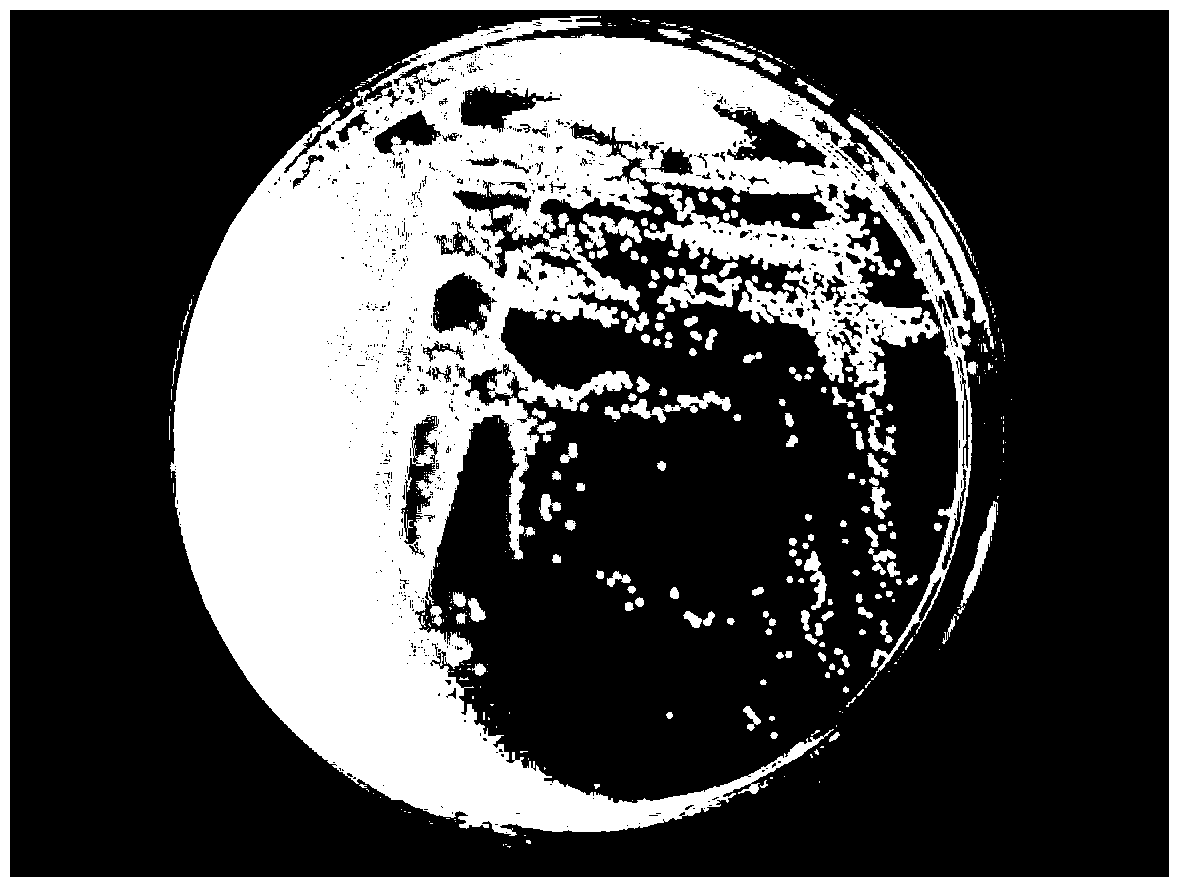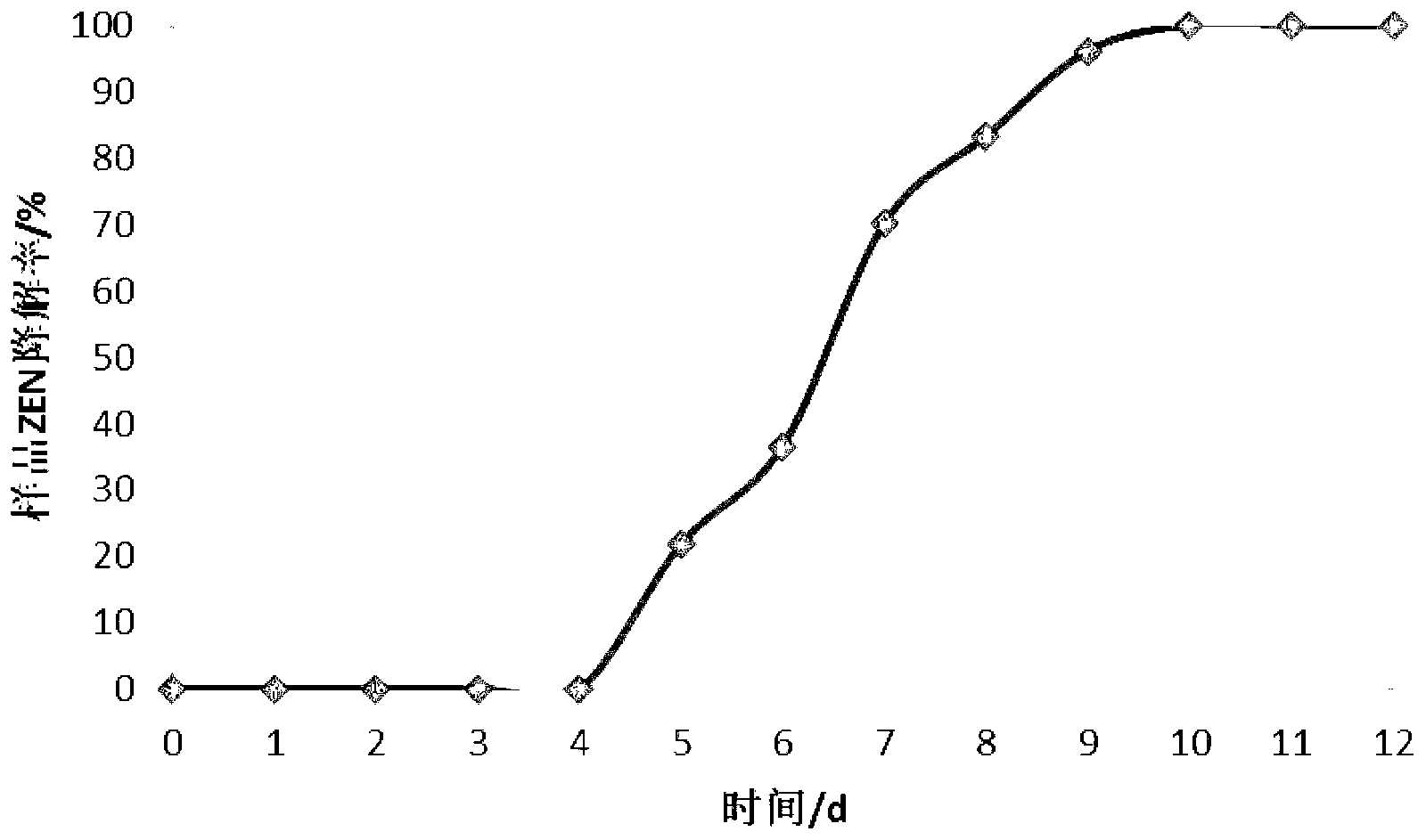Application of Rhodoccus phridinivorans to degradation of zearalenone
A technology of zearalenone and rhodococcus pyridine, applied in the field of microorganisms, can solve problems such as unstable effects, large loss of nutrients, and secondary pollution
- Summary
- Abstract
- Description
- Claims
- Application Information
AI Technical Summary
Problems solved by technology
Method used
Image
Examples
Embodiment 1
[0021] Example 1 Cultivation of Rhodococcus pyridine (CGMCCNo4.1825)
[0022] Training conditions:
[0023] (1) Incline culture: culture time 2-3 days, medium composition (1 liter): 10g tryptone, 5g yeast extract, 10g NaCL, 15g agar (solid), the optimum growth temperature is 26-28℃.
[0024] (2) Seed culture: Pick activated single colony from the slope in the ultra-clean bench and put it into the seed culture solution, shake the bacteria at 28° C. for 2-3 days, and rotate at 220 rpm. Seed culture solution composition (1 liter): 10g tryptone, 5g yeast extract, 10g NaCl.
[0025] (3) Fermentation: Inoculate the seed culture medium according to the inoculum amount of 5%, shake and cultivate for 10-14 days, and the rotating speed is 220rpm. The composition of the culture medium is the same as above.
Embodiment 2
[0026] Example 2 Degradation of zearalenone by Rhodococcus pyridine (CGMCCNo4.1825)
[0027] For the co-culture experiment of Rhodococcus pyridinevorum (CGMCCNo4.1825) and ZEN, the pretreatment and detection conditions of zearalenone HPLC detection refer to the national standard GB / T 5009.209-2008, and a certain amount of fermentation broth is taken every day with high-efficiency The content of ZEN was determined by liquid chromatography.
[0028] Cultivate experimental steps (1), (2) with embodiment 1,
[0029] (3) Zearalenone was added to the culture medium, the concentration of zearalenone was 100 μg / mL, other conditions were the same as in Example 1, and the fermentation broth without ZEN was used as a control.
[0030] Table 1 Degradation effect of Rhodococcus pyridine on ZEN
[0031]
[0032]
[0033] Conclusion: The co-culture experiment of Rhodococcus pyridinevorum (CGMCCNo4.1825) and ZEN has a good effect on the degradation of 100 μg / mL ZEN. The degradation e...
Embodiment 3
[0034] Example 3 Degradation of zearalenone by metabolites of Rhodococcus pyridinevorum (CGMCCNo4.1825)
[0035] Centrifuge the fermented broth of Rhodococcus pyridineivorum (CGMCCNo4.1825) prepared in Example 1 at 4000r / min for 10min, filter and sterilize the supernatant fermented broth with a 0.2μm sterile microporous membrane, then add ZEN at a concentration of 20μg / mL , after the supernatant fermentation broth passed through the 0.22 μm pore size aqueous membrane was treated in a constant temperature water bath at 100°C for 10 minutes, ZEN was added at a concentration of 20 μg / mL as a control. The pretreatment and detection conditions of zearalenone HPLC detection refer to the national standard GB / T 5009.209-2008, and a certain amount of supernatant fermentation broth is taken every day to determine the content of ZEN by HPLC.
[0036] Table 2 Degradation effect of metabolites of Rhodococcus pyridine on ZEN
[0037]
[0038] Conclusion: The metabolites of Rhodococcus p...
PUM
 Login to View More
Login to View More Abstract
Description
Claims
Application Information
 Login to View More
Login to View More - R&D
- Intellectual Property
- Life Sciences
- Materials
- Tech Scout
- Unparalleled Data Quality
- Higher Quality Content
- 60% Fewer Hallucinations
Browse by: Latest US Patents, China's latest patents, Technical Efficacy Thesaurus, Application Domain, Technology Topic, Popular Technical Reports.
© 2025 PatSnap. All rights reserved.Legal|Privacy policy|Modern Slavery Act Transparency Statement|Sitemap|About US| Contact US: help@patsnap.com



